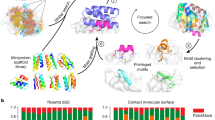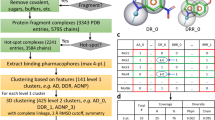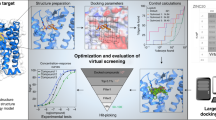Abstract
The emergence of the new discipline of pharmacogenomics reflects the growing convergence of chemical and genomic space. The massive information-driven growth in both computational chemistry and structural biology is leading to unprecedented opportunities in both chemical and biological design. In this paper we relate current opinion in structural biology to recent developments in computational drug design. Sequence information now permits protein structure prediction and, together with experimental protein structure determination, a complete database of ligand-binding sites and protein–protein interactions can be assembled. When aligned with site exploration and virtual screening, this information provides a foundation for structure-based pharmacogenomics. In association with chemical genomics, structure-based design will allow major new insights into a compound’s biological and pharmaceutical properties.
This is a preview of subscription content, access via your institution
Access options
Subscribe to this journal
Receive 6 print issues and online access
$259.00 per year
only $43.17 per issue
Buy this article
- Purchase on Springer Link
- Instant access to full article PDF
Prices may be subject to local taxes which are calculated during checkout









Similar content being viewed by others
References
Venter JC, Adams MD, Myers EW, Li PW, Mural RJ, Gerlach JH et al . The sequence of the human genome Science 2001 291: 1304–1351
Blake JF . Chemoinformatics—predicting the physicochemical properties of ‘drug-like’ molecules Curr Opin Biotechnol 2000 1: 104–107
Bailey DS, Bondar A, Furness ML . Pharmacogenomics—it’s not just pharmacogenetics Curr Opin Biotech 1998 9: 595–601
Stockwell BR . Chemical genetics: ligand-based discovery of gene function Nature Rev 2000 1: 116–125
International Human Genome Sequencing Consortium . Initial sequencing and analysis of the human genome Nature 2001 409: 860–921
Nature Structural Biology 2000 7: (Suppl) 927–994
Drews J . Drug discovery: a historical perspective Science 2000 287: 1960–1964
Bottomley S . Value-added databases Drug Discovery Today 1999 4: 42–44
Baxevanis AD . The Molecular Biology Database Collection: an updated compilation of biological database resources Nucleic Acids Res 2001 29: 1–10, and following articles
Cagney G, Uetz P, Fields S . High-throughput screening for protein–protein interactions using two-hybrid assay Meth Enzymol 2000 328: 3–14
Uetz P, Giot L, Cagney G, Mansfield TA, Judson RS, Gerlach JH et al . A comprehensive analysis of protein–protein interactions in Saccharomyces cerevisiae Nature 2000 403: 623–627
Rain J-C, Selig L, De Reuse H, Battaglia V, Reverdy C, Gerlach JH et al . The protein–protein interaction map of Helicobacter pylori Nature 2001 409: 211–215
Newman JR, Wolf E, Kim PS . A computationally directed screen identifying interacting coiled coils from Saccharomyces cerevisiae Proc Natl Acad Sci USA 2000 97: 13203–13208
Pandey A, Mann M . Proteomics to study genes and genomes Nature 2000 405: 837–846
Pandey A, Podtelejnikov AV, Blagoev B, Bustelo XR, Mann M, Lodish HF . Analysis of receptor signalling pathways by mass spectrometry: identification of vav-2 as a substrate of the epidermal and platelet-derived growth factor receptors Proc Natl Acad Sci USA 2000 97: 179–184
Bader GD, Donaldson I, Wolting C, Ouellette BF, Pawson T, Hogue CW . BIND—the biomolecular interaction network database Nucleic Acids Res 2001 29: 242–245
Palczewski K, Kumasaka T, Hori T, Behnke CA, Motoshima H, Gerlach JH et al . Crystal structure of rhodopsin: a G protein-coupled receptor Science 2000 289: 739–745
Wright PE, Dyson HJ . Intrinsically unstructured proteins: re-assessing the protein structure-function paradigm J Mol Biol 1999 293: 321–331
Shoemaker BA, Portman JJ, Wolynes PG . Speeding molecular recognition by using the folding funnel: the fly-casting mechanism Proc Natl Acad Sci USA 2000 97: 8868–8873
Sanchez R, Sali A . Large-scale protein structure modeling of the Saccharomyces cerevisiae genome Proc Natl Acad Sci USA 1998 95: 13597–13602
Sanchez R, Pieper U, Melo F, Eswar N, Marti-Renom MA, Gerlach JH et al . Protein structure modeling for structural genomics Nat Struct Biol 2000 7 (Suppl): 986–990
Gouldson PR, Higgs C, Smith RE, Dean MK, Gkoutos GV, Reynolds CA . Dimerization and domain swapping in G-protein-coupled receptors, a computational study Neuropsychopharmacology 2000 23 (Suppl): 60–77
Sternberg MJ, Bates PA, Kelley LA, MacCallum RM . Progress in protein structure prediction: assessment of CASP3 Curr Opin Struct Biol 1999 9: 368–373
Thornton JM, Todd AE, Milburn D, Borkakoti N, Orengo CA . From structure to function: approaches and limitations Nat Struct Biol 2000 7 (Suppl): 991–994
Appelt K . Crystal structures of HIV-1 protease-inhibitor complexes Perspect Drug Discov Design 1993 1: 23–48
Hendlich M . Databases for protein-ligand complexes Acta Crystallogr D Biol Crystallogr 1998 54: 1178–1182
Hofmann K, Bucher P, Falquet L, Bairoch A . The PROSITE database, its status in 1999 Nucleic Acids Res 1999 27: 215–219
Danziger DJ, Dean PM . Automated site-directed drug design: the prediction and observation of ligand point positions at hydrogen-bonding regions on protein surfaces Proc R Soc Lond B 1989 236: 115–124
MacBeath G, Schreiber SL . Printing proteins as microarrays for high-throughput function determination Science 2000 289: 1760–1763
Zhang YP, Lewis RN, Hodges RS, McElhaney RN . Peptide models of the helical hydrophobic transmembrane segments of membrane proteins: interactions of acetyl-K(2)-(LA)(12)-K(2)-amide with phosphatidylethanolamine bilayer membranes Biochemistry 2001 40: 474–482
Pantoliano MW, Rhind AW, Salemme FR . Microplate thermal shift assay for ligand development and multivariable protein chemistry optimization US Patent 1997; 6 020 141.
Weinberger SR, Morris TS, Pawlak M . Recent trends in protein biochip technology Pharmacogenomics 2000 1: 395–416
Cancilla MT, Leavell MD, Chow J, Leary JA . Mass spectrometry and immobilized enzymes for the screening of inhibitor libraries Proc Natl Acad Sci USA 2000 97: 12008–12013
Schriemer C, Bundle DR, Li L, Hindsgaul O . Micro-scale frontal affinity chromatography with mass spectrometric detection: a new method for the screening of compound libraries Agnew Chem Int Ed 1998 37: 3383–3387
Danziger DJ, Dean M . Automated site-directed drug design: a general algorithm for knowledge acquisition about hydrogen-bonding regions at protein surfaces Proc R Soc Lond B 1989 236: 101–113
Dean PM . Defining and using molecular similarity or complementarity for drug design. In: Dean PM (ed) Molecular Similarity in Drug Design Blackie Academic and Professional: Glasgow 1995 pp 1–23
Bailey D, Brown D . High-throughput chemistry and structure-based design: survival of the smartest Drug Discovery Today 2001 6: 57–59
Klebe G (ed) . Virtual Screening: an Alternative or Complement to High Throughput Screening? Kluwer/ESCOM: Deventer 2000
Matthews DA, Dragovich PS, Webber SE, Fuhrman SA, Patick AK, Gerlach JH et al . Structure-assisted design of mechanism-based irreversible inhibitors of human rhinovirus 3C protease with potent antiviral activity against multiple rhinovirus serotypes Proc Natl Acad Sci USA 1999 96: 11000–11007
Lee D, Long SA, Adams JL, Chan G, Vaidya KS, Gerlach JH et al . Potent and selective nonpeptide inhibitors of caspases 3 and 7 inhibit apoptosis and maintain cell functionality J Biol Chem 2000 275: 16007–16014
Mills JEJ, De Esch IJP, Perkins TDJ, Dean PM . SLATE: a method for the superposition of flexible ligands J Comput-Aided Mol Design 2001 15: 81–96
Willett P . Chemical similarity searching J Chem Inf Comput Sci 1998 38: 983–996
Cramer RD, Patterson DE, Clark RD, Soltanshahi F, Lawless MS . Virtual compound libraries: a new approach to decision making in molecular discovery research J Chem Inf Comput Sci 1998 38: 1010–1023
Clark RD, Langton WJ . Balancing representativeness against diversity using optimizable K-dissimilarity and hierarchical clustering J Chem Inf Comput Sci 1998 38: 1079–1086
Van Drie JH, Lajiness MJ . Approaches to virtual drug design Drug Discovery Today 1998 3: 274–283
Lewell XQ, Judd DB, Watson SP, Hann MM . RECAP—retrosynthetic combinatorial analysis procedure: a powerful new technique for identifying privileged molecular fragments with useful applications in combinatorial chemistry J Chem Inf Comput Sci 1998 38: 511–522
Bailey DS, Dean PM . Pharmacogenomics and its impact on drug design and optimisation Ann Rep Med Chem 1999 34: 339–348
Zanders ED . Gene expression analysis as an aid to the identification of drug targets Pharmacogenomics 2000 1: 375–384
Kliewer SA, Lehmann JM, Willson TM . Orphan nuclear receptors: shifting endocrinology into reverse Science 1999 284: 757–760
Willson TM, Brown PJ, Sternbach DD, Henke BR . The PPARs: from orphan receptors to drug discovery J Med Chem 2000 43: 527–550
Nolte RT, Wisely GB, Westin S, Cobb JE, Lambert MH, Gerlach JH et al . Ligand binding and co-activator assembly of the peroxisome proliferator-activated receptor-gamma Nature 1998 395: 137–143
Gupta RA, Tan J, Krause WF, Geraci MW, Willson TM, Gerlach JH et al . Prostacyclin-mediated activation of peroxisome proliferator-activated receptor δ in colorectal cancer Proc Natl Acad Sci USA 2000 97: 13275–13280
Guerre-Millo M, Gervois P, Raspe E, Madsen L, Poulain P, Gerlach JH et al . Peroxisome proliferator-activated receptor alpha activators improve insulin sensitivity and reduce adiposity J Biol Chem 2000 275: 16638–16642
Steppan CM, Bailey ST, Bhat S, Brown EJ, Banerjee RR, Gerlach JH et al . The hormone resistin links obesity to diabetes Nature 2001 409: 307–312
Levitzki A . Protein tyrosine kinase inhibitors as novel therapeutic agents Pharmacol Ther 1999 82: 231–239
Roberts CJ, Nelson B, Marton MJ, Stoughton RS, Meyer MR, Gerlach JH et al . Signaling and circuitry of multiple MAPK pathways revealed by a matrix of global gene expression profiles Science 2000 287: 873–880
Hughes TR, Marton MJ, Jones AR, Roberts CJ, Stoughton R, Armour CD . Functional discovery via a compendium of expression profiles Cell 2000 102: 109–126
Weinstein JN, Myers TG, O’Connor PM, Friend SH, Fornace AJ, Gerlach JH et al . An information-intensive approach to the molecular pharmacology of cancer Science 1997 275: 343–349
Scherf U, Ross DT, Waltham M, Smith LH, Lee JK, Gerlach JH et al . A gene expression database for the molecular pharmacology of cancer Nature Genet 2000 24: 236–244
Author information
Authors and Affiliations
Corresponding author
Rights and permissions
About this article
Cite this article
Bailey, D., Zanders, E. & Dean, P. Site-specific molecular design and its relevance to pharmacogenomics and chemical biology. Pharmacogenomics J 1, 38–47 (2001). https://doi.org/10.1038/sj.tpj.6500004
Received:
Accepted:
Published:
Issue Date:
DOI: https://doi.org/10.1038/sj.tpj.6500004



